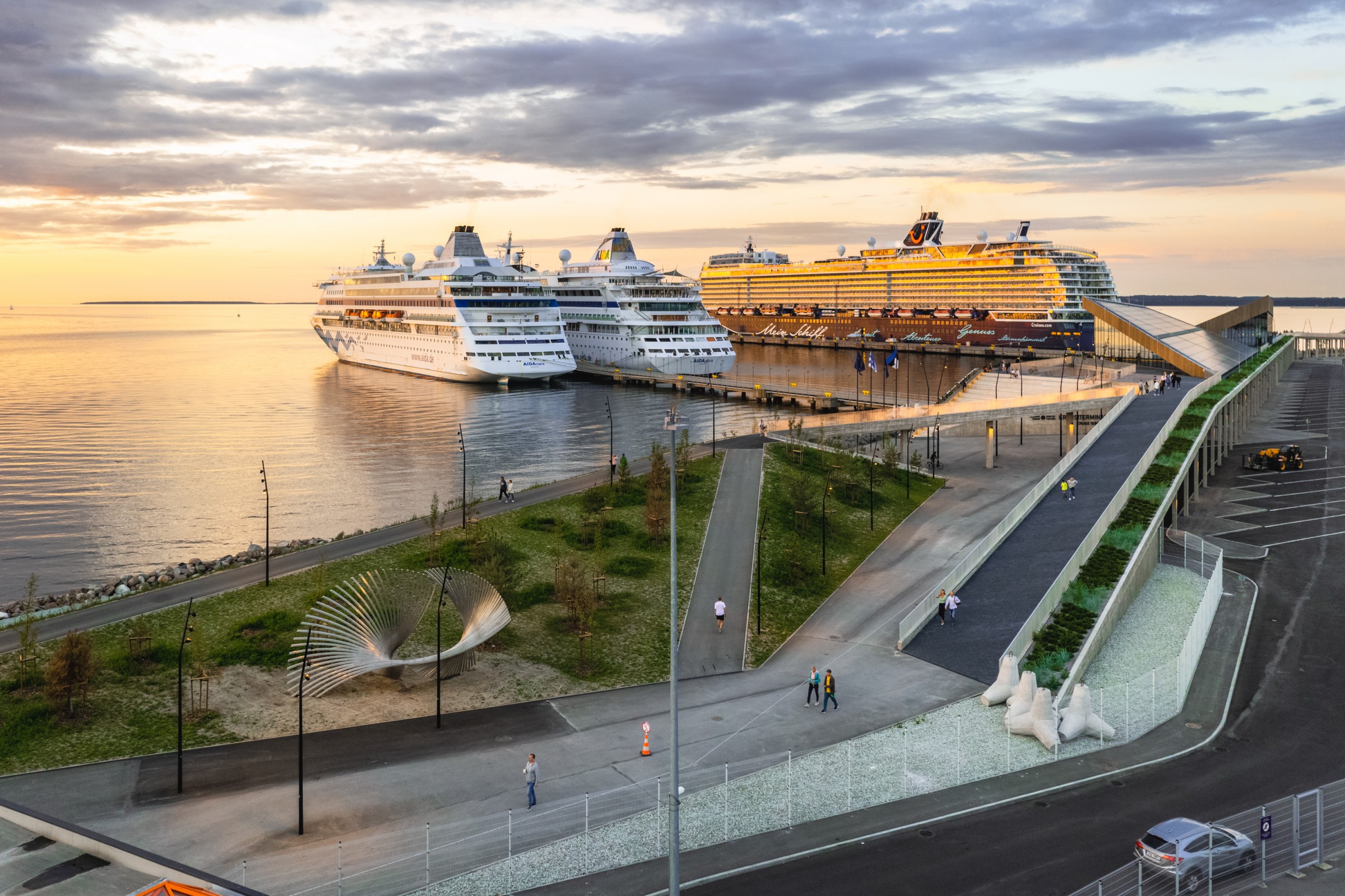ESPO Award 2022: let us present the shortlisted projects: Tallinn Port Authority
13 October 2022
The ESPO Award 2022 will go to the port managing body which has developed a series of initiatives and/or a strategy in collaboration with the different stakeholders and the city to enhance the maritime passenger links and the connectivity within the city or with other cities and regions of Europe, be it for its own citizens or for allowing visitors from all over the world to visit and discover the city and bring added value to the local community. The role of the port in enhancing the connectivity through a smooth and friendly passage through the port in and out of the city, as well as efforts of the port to give visitors a first good impression of the city or region are important criteria. Environmental and social sustainability of the project or strategy will be a prerequisite for winning the ESPO Award 2022.
The four projects that are shortlisted for this year’s Award are the projects of ports of Ceuta (Spain), Barcelona (Spain), Tallinn (Estonia) and the cooperation project of the ports of Ancona, Ravenna, Venice, Trieste, Rijeka, Zadar, Split and Dubrovnik (Italy and Croatia).
ESPO is proud to present the shortlisted projects before the winner is announced during the traditional ESPO Award Ceremony and Dinner taking place on 8 November in Brussels. We start with the project of the Port of Tallinn.
Tallinn Port Authority
Development of the Tallinn Old City Harbour/Tallinn Old City Harbour’s new cruise terminal
Congratulations! You have been shortlisted for the ESPO Award 2022! Could you briefly describe your project?
Thank you! It is an honor see our hard work and sustainable mindset being appreciated at the international stage. The intention of the project is to integrate our seafront with the local community in order to create a friendly and intelligent urban environment for both the residents and visitors of Tallinn.
During the Middle Ages the Old City Harbour was the northernmost harbour of the Hanseatic League trade alliance. Today, the port of Tallinn group is one of the largest cargo- and passenger port complexes in the Baltic Sea region, which usually serves over 10 million passengers and over 20 million tons of cargo annually.
Through developing the urban environment, we want to promote the historic significance of the port as well as the forward-looking values exemplified by using innovative technologies and a strong emphasis on local and international cooperation.
 © Port of Tallinn/Kaupo Kalda
© Port of Tallinn/Kaupo Kalda
How has your project contributed to enhancing the city connectivity with regards to maritime passenger transport? Could you tell us more? How does your project contribute to bringing added value to the local community?
The project aims to overhaul the entire harbour area into a sustainable, attractive and multipurpose urban area with possibilities for everybody to enjoy. The harbour aspires to be the heart of the Tallinn central area – a place both visitors and locals alike could visit and spend time in.
Last year, a new smart and green cruise terminal which also can be used as a venue for a multitude of different events and a nearly kilometer-long rooftop promenade were opened. The new terminal is the most contemporary in the region, designed with the environment and sustainability in mind. Beside leaving the cruise guests an indelible first impression and better service, it is also gives the opportunity for the event organizers to create more value to the community by bringing more national and international events with smaller environmental footprint. The promenade, which connects the seafront with the city centre, has opened the area for the citizens and guests of Tallinn - the promenade has plenty of seating areas, a restaurant, a children’s playground and outdoor gym. The goal was to build something that is not only a state-of-the-art terminal for tourists who visit Tallinn but something that will be seen as an integral part of the urban environment – an opportunity for the residents and visitors of Tallinn to reclaim the access to the sea.
The construction of the new cruise terminal is the first step in reconstructing the entire port area that aims to provide the public with better access to the seaside by opening the port area to recreational, commercial and residential use. In order to achieve this goal, the entire harbour area will be overhauled. Visual improvements include turning the parking lots into parks with seaside seating areas and walkways. Functional improvements see the harbour area with new and improved opportunities for the passengers to move quicker from one terminal to the other, park their cars more conveniently board the ships in better conditions than before. The harbour area will also be better connected with public transportation providing everybody with less congestion, less noise pollution and with the reduction of car-traffic comes an overall better environment for everyone.
 © Port of Tallinn/Kaupo Kalda
© Port of Tallinn/Kaupo Kalda
Could you describe the original and innovative character of your project?
In addition to the fact that the terminal is constructed with the local community in mind, it is also environmentally sustainable. The technical design of the terminal is inspired by a study carried out as part of the Green Cruise Port project. We see sustainability and innovativeness as our competitive advantage. We apply in practice the slogan of the port “Think smart, act green“.
The building’s energy needs are met by 725 solar panels adapted to the Nordic climate. It covers 35% of the energy requirement in the cold part of the year, while it provides up to 100% of the energy requirements in the summertime. The building is heated and cooled by two heat pumps that are connected to an innovative seawater heat exchange. These decisions allow the facility to also operate outside the cruise season – hosting events, concerts, and conferences. At the berth places, innovative wastewater reception facilities are present. This innovation, called the micro tunnel, reduces the flow of wastewater to the city’s sewer systems as the sewers in Tallinn cannot handle the wastewater volume.
The new terminal makes the capital of Estonia, and all the city has to offer more accessible through implementing innovative ideas – the aim is that all tourists leave with a safe and unforgettable travel experience and that cruise lines are able to reduce their environmental footprint by using environmentally friendly port facilities.
Why do you think your project deserves to win the ESPO Award 2022?
Tallinn’s strong historic ties to the sea were severed during the second half of the 20th century when the Soviet regime developed coastline areas with the intent of keeping people away from access to the sea in order to minimize the risk of people fleeing the Soviet Union. The aim when constructing the new cruise terminal was to reinvigorate the historic tie between the sea and the city by reimagining the port’s infrastructure with the intent to open the seaside to the city and vice versa.
A year after the construction has ended the terminal has proven to be a popular destination for the locals to come and enjoy the rooftop promenade with beautiful views to the sea. The restaurant on top of the terminal has received critical acclaim and is the go-to place for everybody looking for the finest seafood in Tallinn. The terminal building has also become a staple venue for high profile social events, concerts and conferences.
With the addition of the new cruise terminal, the port which used to be a utilitarian area where function took precedence over form has begun its transformation into an environment that is welcoming to everyone. The goal of the project is to unify the city centre and the three historic districts surrounding the port area, that have been disconnected from each other for decades.
Furthermore, we have found that being part of ESPO and Eco Ports networks and applying for ESPO Award is immensely helpful in providing a way for ports to discuss environmental issues and share best practices of sustainability. The ability to say that Port of Tallinn is an EcoPort member allows us to demonstrate to all our stakeholders that we are being proactive on environmental issues and supporters of sustainable development of ports.
“In Port of Tallinn we firmly believe that Tallinn’s city centre should be more open to sea. That is why we are committed to work on towards a general reimagining of the area to connect with the city seamlessly without the visitors of the harbour not even noticing when they enter or leave the harbour territory.”
Valdo Kalm, CEO of Port of Tallinn
With the support of:


Related documents
No attachments.
